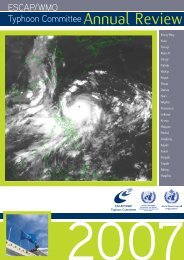TCAR - Typhoon Committee
TCAR - Typhoon Committee
TCAR - Typhoon Committee
Create successful ePaper yourself
Turn your PDF publications into a flip-book with our unique Google optimized e-Paper software.
82<br />
ESCAP/WMO<br />
<strong>Typhoon</strong> <strong>Committee</strong> Annual Review 2009<br />
divergence, vertical motion and potential vorticity<br />
fields as well as the equatorward propagation of<br />
the cold surges in triggering monsoon disturbances<br />
over the South China Sea and subsequently causing<br />
heavy rainfall especially over the coastal areas of east<br />
coast of Peninsular Malaysia and Sarawak.<br />
Research work on ensemble forecasting related<br />
to numerical weather modeling and verification of the<br />
operational wave model is part of an effort to obtain<br />
more accurate and reliable numerical forecasts. The<br />
research work on climate extremes is an effort to<br />
investigate the behavior of extreme phenomena<br />
related to the Malaysian climate using A1B, A2 and B2<br />
scenario outputs. There is very little work done<br />
thus far to look at the impacts of tropical cyclones<br />
in the Bay of Bengal upon the weather in Malaysia.<br />
This work will definitely gives very useful information<br />
on how the tropical cyclones in the Bay of Bengal<br />
influence the weather over Malaysia, especially<br />
Peninsular Malaysia.<br />
Two officers from the MMD had attended the numerical<br />
weather modeling related training at the Korea<br />
Meteorological Administration (KMA) and the Japan<br />
Meteorological Agency (JMA). The training session<br />
at KMA was related to data assimilation processes<br />
involved in using WRF-VAR. Meanwhile the training<br />
session at JMA was to introduce the operational<br />
numerical weather model at JMA and to impart technical<br />
know how regarding methodology of using initial<br />
conditions from the JMA numerical weather model.<br />
Four scientists from the Chinese Meteorological<br />
Administration (CMA) were also invited to MMD<br />
to introduce the concepts of <strong>Typhoon</strong> Bogussing,<br />
verification of numerical weather prediction output<br />
and ensemble technique to MMD officers.<br />
Courses related to flood and hydrology organized<br />
by the Department of Drainage and Irrigation (DID)<br />
during this year are as follows:<br />
i. “Basic Hydrology for Engineers”, Kuala Lumpur, 5<br />
– 7 May 2009.<br />
ii. “Applied Hydrology for Engineers”, Kuala Lumpur,<br />
17 - 19 Feb 2009.<br />
iii. “Hydraulics and Catchment Modelling”, Kuala<br />
Lumpur, 23 – 26 Mac 2009.<br />
iv. “Hydraulics and Flood Mapping Modelling”, Kuala<br />
Lumpur, 4 – 6 August 2009.<br />
v. “3rdOn The Job Training (OJT)”, DID, Kuala<br />
Lumpur, 21 July – 23 August 2009.<br />
Information and Communication Technology (ICT)<br />
In this age of information, the media plays a crucial<br />
role in inculcating a culture of safety and resilience.<br />
The mass media is an effective platform to raise<br />
awareness among the public on risk reduction<br />
and disaster preparedness measures. Realizing the<br />
importance of the media in disaster risk reduction,<br />
the Ministry of Information, Communication and<br />
Culture has established a Disaster Unit in the<br />
Department of Broadcasting Malaysia.<br />
ICT is also an essential medium to promote awareness<br />
and disseminate warnings to the community. In this<br />
respect, a Fixed-Line Disaster Alert System (FLAS) is<br />
put in place to disseminate disaster alert from the<br />
authorities to the public. A separate system known<br />
as the Government Integrated Radio Network (GIRN)<br />
on the other hand provides radio communication<br />
between responders during emergency or disaster.<br />
Disaster reporting by affected civilians is now more<br />
efficient via the Malaysia Emergency Response<br />
System (MERS) emergency hotline, 999.<br />
Early warning information for disasters are<br />
disseminated via sirens, short messaging system<br />
(SMS), telephone, telefax, webpage, mass media<br />
broadcasting system and public announcement. The<br />
dissemination of information in a timely manner is<br />
crucial to ensure that the vulnerable communities and<br />
responders are promptly informed to enable them<br />
to take necessary actions.<br />
Towards the end of last year and early this year,<br />
communication lines at the MMD headquarters and<br />
Regional Forecast Offices had been upgraded. At the<br />
headquarters, the LAN lines have been upgraded<br />
from 3 Mbytes to 8 Mbytes. At the Regional Forecast<br />
Offices, the LAN lines have been upgraded from 512<br />
Kbytes to 2 Mbytes. The Short Messaging System<br />
Meteorological Information System (SMSMIS) was<br />
operationalized at the end of last year. Dissemination<br />
of critical weather information and warnings with<br />
minimal hindrances and at a faster speed has been<br />
achieved using the upgraded LAN lines.<br />
3.0 Resource Mobilization Activities<br />
Department of Social Welfare<br />
Annually, before the advent of the Northeast<br />
Monsoon, the Department of Social Welfare<br />
together with other government agencies do the<br />
necessary preparations to give the best possible<br />
aid to victims in the face of severe weather<br />
related disasters such as flooding and landslides.<br />
Among the measures that have been adapted are:<br />
i. Identification of 4744 relief or evacuation centers<br />
that can handle up to 3 million victims at any one time<br />
if required;<br />
ii. 402 ration storage centers have been set up at

















